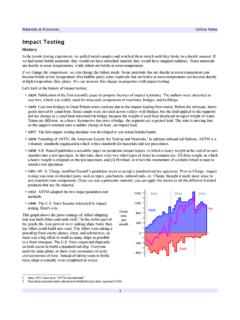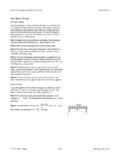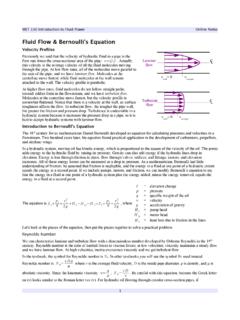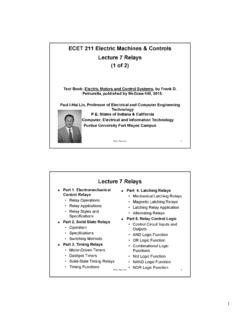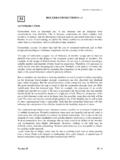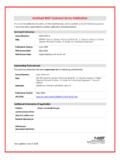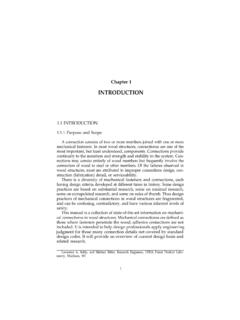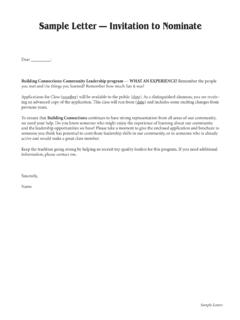Transcription of Shear and moment diagrams - IPFW
1 Notes for Strength of Materials, ET 200 Shear & Bending moment diagrams 2011 Barry Dupen 1 of 12 Revised 4 May 2011 Shear Force and Bending moment in Beams Beam Loads The way a part is loaded determines whether it is called a tensile or compressive member, a torsional shaft, or a beam. If you take a inch diameter steel rod and pull it lengthwise, the rod will de-velop a tensile stress !=P/A where A is the cross-sectional area of the rod. Loading the rod in tension parallel to its axis makes the rod a ten-sile member; loading it in compression parallel to its axis makes it a compressive member. If you twist the steel rod with torque T, then we call it a torsional shaft. If loading is perpendicular (transverse) to its axis so that the rod bends, then the rod called a beam.
2 You can load a beam with point loads, uniformly distributed loads, or nonuniformly distributed loads. A student standing on the end of a diving board is an example of a point load: a force applied at a single point on the beam. This point load P could be the weight of an object on the beam, or it could be a load applied by a cable or rod attached to the beam at that point. For each loaded beam we draw beam reactions: forces RA and RB for a simply supported beam; force RB and moment MB for a canti-lever beam. The symbols for supports indicate the kinds reactions that develop at the support. For example, support A is pinned, like a hinge, so the symbol is a triangle. A pinned support may have vertical and horizontal reaction forces, but the beam at the right has no applied horizontal loads, therefore RAx = 0.
3 In the beam problems that fol-low, there are no applied horizontal forces, so the horizontal reac-tion force is zero, and the vertical reaction forces RAy and RBy are abbreviated RA and RB. If the beam sits on a roller that allows the beam to move freely horizontally, then the symbol is a circle. A roller support has only a vertical reaction force. A cantilever beam is embedded in a wall, therefore the beam has vertical and horizontal reaction forces as well as a reaction mo-ment. The horizontal reaction force RBx is zero as long as there are no horizontal applied forces, so the vertical reaction force RBy is usually abbreviated RB. Notes for Strength of Materials, ET 200 Shear & Bending moment diagrams 2011 Barry Dupen 2 of 12 Revised 4 May 2011 The weight of a beam is an example of a uniform distributed load.
4 The weight per unit length, w, typically has units of , kips/ft., or kN/m. Consider a wide-flange beam, or W-beam, having a cross-section that looks like a Courier font capital letter I. The Customary W-beam designation system has two numbers: the first is the nominal depth, and the second is the weight per unit length. For example, a W24 162 beam has a nominal depth of 24 inches and a weight per unit length of 162 If the beam is 10 feet long, then the total weight, W, of the beam is W=wL= Canada uses SI (metric) units to specify W-beams. These beams are designated by mass, not weight: a W250 115 wide flange beam has a nominal depth of 250 mm and a mass per unit length of 115 kg/m. From Newton s Second Law, force = mass accel-eration, or weight = mass the acceleration of gravity.
5 The SI unit of force is the newton (N), defined as N=kgms2, and the ac-celeration of gravity is m/s2. The weight per unit length of a W250 115 beam is w= If the beam is 4 m long, then the total weight, W, of the beam is W=wL= A distributed load may run the length of the beam, may run along a portion of the beam, or may be nonuniform, like this tapered distributed load. Reactions for Simply-Supported Simple Beams You can calculate the reaction forces for a symmetrically-loaded beam by dividing the total load by 2, because each end of the beam carries half the load. The reactions for the beam with a point load are RA=RB=P 2. In this example, RA=RB=30kN 2=15kN. The reaction forces for a beam with a uniform distributed load are RA=RB=wL 2.
6 In this example, RA=RB= !"#$%& 2=2000lb. If the loading is not symmetrical, then the beam reactions are cal-culated using Statics equations: the sum of the vertical forces equals zero, and the sum of the moments about a point equals zero. From Statics, you know how to calculate the moment about a point: in this example, MA=Px. Notes for Strength of Materials, ET 200 Shear & Bending moment diagrams 2011 Barry Dupen 3 of 12 Revised 4 May 2011 In a beam problem, you can pick a point at either support. In this example, select point A. Since moment has a magnitude and a direction (clockwise or counterclockwise), we need to establish a convention for positive and negative moments. We ll select coun-terclockwise as positive, symbolized as , and start adding up the moments.
7 The 40 kN load acts at a distance of 3m from point A. Think of point A as a hinge 40 kN load causes the beam to rotate clockwise about point A, so the moment is negative. The reaction force RB acts at a distance of 10m from point A, and causes the beam to rotate counterclockwise about point A, so the moment is positive. The moment about point A is !MA=0="40kN3m+RB10m. Now solve for the reaction force RB=40kN3m10m=12kN. Use the sum of the forces in the vertical direction to calculate the other reaction force. Forces have magnitude and direction; pick upwards as positive, so !Fy=0=RA"40kN+12kN. Now solve for the reaction force RA=40kN!12kN=28kN. You can check your answer by solving the sum of the moments about point B.
8 Use the same technique for beams with more than one point load. The moment about point A is !MA=0=" "" "+RB10". Solve for the reaction force RB= + Sum of the forces !Fy=0=RA"5lb."12lb.+ Solve for RA=5lb.+12lb.! If a uniformly distributed load is not symmetrical, then we need to convert the distributed load into a point load equivalent to the total load W=wL1 where L1 is the length of the distributed load. The equivalent point load is located at the centroid of the distributed center of the rectangle. Use the equivalent load diagram for calculating the reaction forces. For example, if L1 = 6m, total length L = 10m, and w = , then the equivalent point load W=wL1= , and the location of the equivalent point load L2 = 3m from the left end.
9 The numerical solution is identical to the previous example. Notes for Strength of Materials, ET 200 Shear & Bending moment diagrams 2011 Barry Dupen 4 of 12 Revised 4 May 2011 Use the same approach for a nonuniformly distributed load. Again, the location of the equivalent load is at the centroid of the distrib-uted load. The centroid of a triangle is one-third the distance from the wide end of the triangle, so the location of the equivalent load is one-third of the length measured from the right end of this beam. The load varies from 0 at the left end to w at the right end; there-fore, the total load is the average of these loads times the beam length: W=0+w2L=wL/2. If the beam has a point load and a distributed load, draw an equivalent load diagram with the applied point load and the equivalent point load.
10 The moment about point A is !MA=0=" " +RB10ft. Solve for the reaction force RB= + Sum of the forces !Fy=0=RA"150lb."200lb.+ Solve for RA=150lb.+200lb.! Overhanging and Cantilever Beams A simply-supported beam is supported by pinned connections at both ends; all applied loads lie between these two points. An over-hanging beam is loaded beyond the supports. If the beam extends beyond the supports, then loads applied beyond the supports are called cantilever loads. The solution method is the same as for simply-supported beams: use the sum of the moments about one of the support points to find the reaction at the other support point. Here, the sum of the moments about point A is !MA=0=50kN5m"30kN11m+RB15m Note the 50kN load produces a positive (counterclockwise) mo-ment about point A.

